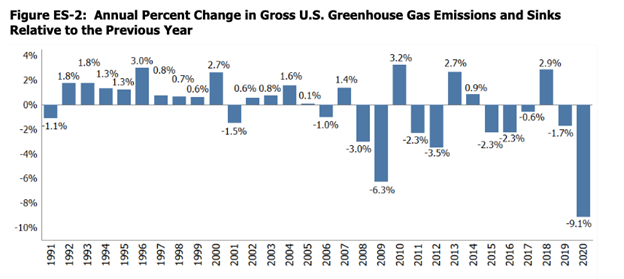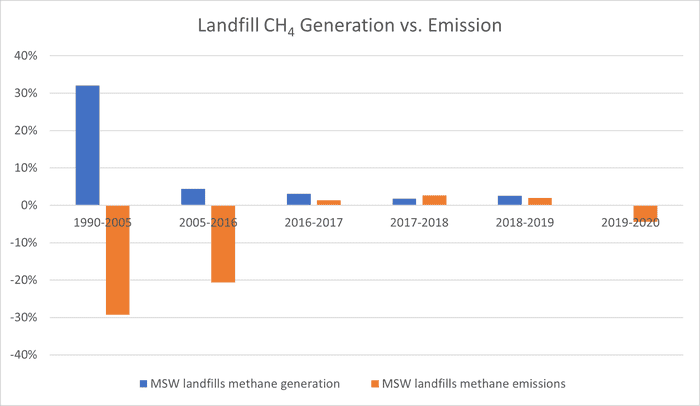Measuring and Reducing Methane Emissions from MSW Landfills
Most of the reductions in MSW landfill methane emissions occurred between 1990 and 2005 where MSW landfills methane emissions dropped by nearly 30%. In that same time period, MSW landfill methane generation actually increased by 32%. In order to accomplish such a significant drop while increasing methane generation, the amount of methane controlled by MSW landfills more than tripled. Overall, in the thirty-year span from 1990 to 2020, MSW landfill methane generation increased by 48.4% while MSW landfill methane emissions dropped by 43.1%.

In 2009, the U.S. made a commitment to reduce greenhouse gas (GHG) emissions by at least 17% by 2020 when compared to 2005 levels. The U.S. Environmental Protection Agency (USEPA) just released the Draft Inventory of U.S. Greenhouse Gas Emissions and Sinks covering the period 1990-2020, and guess what? That 17% was achieved! In fact, U.S. GHG emissions were reduced by almost 20%. Hence, the target goal was not just met but exceeded by a significant margin. This was not anticipated given that through 2019, the reduction was only about 12% lower than 2005 making the target seem to be impossibly out of reach. However, with the pandemic, fossil fuel combustion emissions dropped by a whopping 10.7% in a single year resulting in an overall, all sector 9.1% drop (See Figure 1). With this decline, fossil fuel emissions also dropped below 1990 levels.
In general, total U.S. GHG emissions rose between 1990 to 2007 where it peaked. Since then, the trend has been generally declining but had not dropped below 1990 levels, until 2020. For 2020, at least, the numbers are 7.4% lower than in 1990. As can be seen, this is the largest single year dip in emissions to date. The COVID-19 pandemic was the biggest driver of the decreased emissions reducing demand across all sectors aided by a significant decrease in travel. For instance, the pandemic led to a 13.2% decrease in vehicle miles traveled in 2020 compared to 2019. However, the EPA also credits the continued decarbonization of the power sector, the result of a “continued shift from coal to less carbon intensive natural gas and renewables” and increase in new vehicle fuel economy. Add to that, the decline also reflects the combined impacts of many other long-term trends, including population, economic growth, energy market trends, and technological changes that support energy efficiency.

Figure 1: Year over year change in GHG emissions. Source: USEPA GHG Inventory
That being said, what about landfills? Did they also have a similar drop? Landfill had an even greater drop, but not in 2020. For the period from 2019 to 2020, net methane emissions from municipal solid waste (MSW) landfills did drop by about 4.5%, which is significant. However, unlike the majority of other sectors covered by the GHG Inventory, MSW landfills methane emissions declined significantly since the GHG inventory first starting reporting emissions in 1990. Most of the reductions in MSW landfill methane emissions occurred between 1990 and 2005 where MSW landfills methane emissions dropped by nearly 30%. In that same time period, MSW landfill methane generation actually increased by 32% (see Figure 2). In order to accomplish such a significant drop while increasing methane generation, the amount of methane controlled by MSW landfills more than tripled. Overall, in the thirty-year span from 1990 to 2020, MSW landfill methane generation increased by 48.4% while MSW landfill methane emissions dropped by 43.1%. To put it another way, in 1990, over 80% of the methane that was generated at an MSW landfill was emitted. In 2020, only about 30.9% is emitted.

Figure 2: Landfill methane generation & emissions. Data source: USEPA GHG Inventory
Determining methane emissions from MSW Landfills
There is a maxim: If you can’t measure it, you can’t manage it. For MSW landfills, this has not been the case. MSW landfill operators have estimated landfill gas generation and installed landfill gas collection and control systems resulting in significantly reduced methane emissions. But what is not well understood is that these reductions occurred without measuring and quantifying landfill emissions. There is no currently accepted practice for measuring emissions from landfills. Given that, how are methane emissions from MSW landfills determined?
Through its Greenhouse Gas Reporting Program, EPA required that facilities within the United States that emit more than 25,000 metric tons of carbon dioxide equivalent emissions per year to report their greenhouse emissions. For MSW landfills, this means calculating methane emissions. For comparison between different greenhouse gases, the US GHG Inventory utilizes a common unit, carbon dioxide equivalent or CO2 Eq. The methane is converted to a carbon dioxide equivalent by multiplying emissions by a factor of 25.
To determine emissions, MSW landfills must calculate them using two methodologies and then generally report the higher of the two. The first method is to model the total amount of landfill gas that is generated based on the amount, type and age of waste. The modeled landfill gas generation is then reduced by the amount that is recovered through the landfill gas collection system and any oxidation.
The second methodology is dependent on the amount of landfill gas recovered. The calculation assumes that there is a maximum amount of landfill gas that can be recovered. That maximum amount is called the collection efficiency. The collection efficiency is 0% for landfills without active collection. If a landfill has only daily cover soil and active collection, then the collection efficiency is 60%. An active landfill with intermediate cover has a collection efficiency that maxes out at 75%. With final cover, the collection efficiency maxes out at 95%. The recovered amount is divided by the collection efficiency which is then reduced by any oxidation. Perversely, this means that the more landfill gas that is recovered, the higher the emissions will be.
For example, using this method, if an MSW landfill with intermediate cover and an active landfill gas collection system collects 5000 tons of methane, using the collection efficiency of 75%, 1667 tons of methane will not be collected. Assuming 10% oxidation, that MSW landfill will be calculated to emit 1500 tons of methane. If that same landfill made improvements to its landfill gas collection system and successfully collected 20% more landfill gas or 6000 tons of methane but had the same cover, it would be subject to the same collection efficiency. As a result, the MSW landfill would be calculated to emit more methane. In this case, 2000 tons of methane would not be collected and after 10% oxidation, the MSW landfill would be calculated to emit 1800 tons of methane.
Because landfills generally report the higher of the calculations using the two methodologies, improving landfill gas collection will generally not result in lower reported emissions. Instead, as some MSW landfill operators know, the more they collect, the more the calculations will say they emit.
To obtain an estimate for emissions from all MSW landfills in the country, EPA starts with the data from the Greenhouse Gas Reporting Program (GHGRP). However, because not all MSW landfills are required to report under the GHGRP, EPA accounts for non-reporting MSW landfills by applying a scale-up factor to the reporting MSW landfills to arrive at the total MSW landfill emissions estimate.
Measuring methane emissions from MSW Landfills
Clearly, there are issues with the calculated emissions. Should methane emissions from MSW landfills be measured instead? Ideally yes. Unfortunately, although attempts have been made to measure MSW landfill emissions, there is no currently accepted protocol for measuring emissions. As part of complying with the NSPS, MSW landfills are required to conduct quarterly surface emission monitoring (SEM) where they conduct a survey of the landfill looking for any emissions and addressing those emissions within a prescribed timeframe. However, the SEM does not translate into a measurement. Instead, it is utilized as a method to detect and address leaks. Preferably, any new measurement methodology should be accepted and approved by EPA for reporting purposes.
What next?
Of course, with the anticipation of end of the pandemic, can the 2020 drop in fossil fuel emissions be expected to be sustained into 2021? And how will that impact the overall GHG emission? It is likely that we experienced a one-year aberration. In order to meet the GHG reduction goals, we still have a long way to go. With the inevitable backslide on the 2020 emissions numbers, will future targets be met?
In April 2021, the Biden administration announced the next major target for the country as a 50-52% reduction from 2005 levels by 2030. In 2020, MSW landfills have decreased GHG emissions by almost 20% from 2005 levels. However, with only eight years until 2030, dropping that by another 30% will be a significant challenge. Not only that, but MSW landfills are facing a lot of scrutiny. In November 2021, the White House released its U.S. Methane Emissions Reduction Action Plan which included actions to reduce methane emissions from landfills. Actions include the issuance of the federal plan in May 2021, new emphasis on EPA’s Landfill Methane Outreach Program (LMOP) and working with federal agencies to reach the goal of 50% reduced food loss and waste by 2030.
In January 2022, the White House announced the formation of a Greenhouse Gas (GHG) Monitoring & Measurement Interagency Working Group to help identify and deploy the best available tools and data systems to measure, monitor, report, and verify (MMRV) carbon dioxide, methane, and other GHG emissions and removals. The Working Group, co-led by the White House Office of Science and Technology Policy, the Office of Management and Budget, and the White House Climate Policy Office, will work with scientists, technologists, and mappers to develop a comprehensive national GHG MMRV system that will disseminate validated, science-based GHG data. In the near term, one item the Working Group will focus on is methane emissions and removals under the U.S. Methane Emissions Reduction Action Plan.
MSW landfills were able to significantly reduce emissions by installing landfill gas collection and control systems. Ultimately, given the constraints of the current methane emissions calculations methodology used for reporting, the industry may not be able to continue to reduce emissions without reconsidering the approach.
About the Author
You May Also Like


